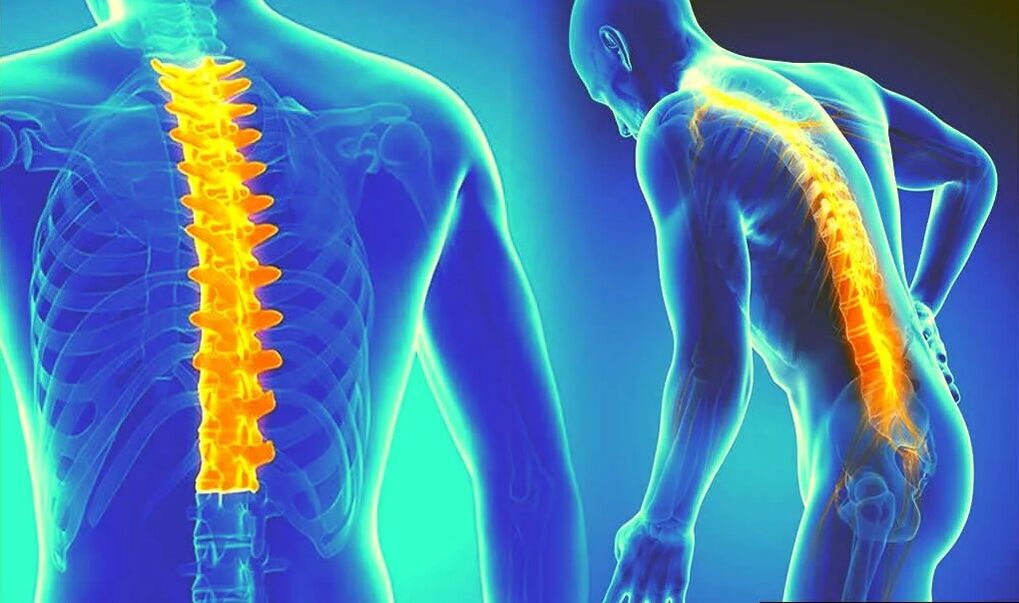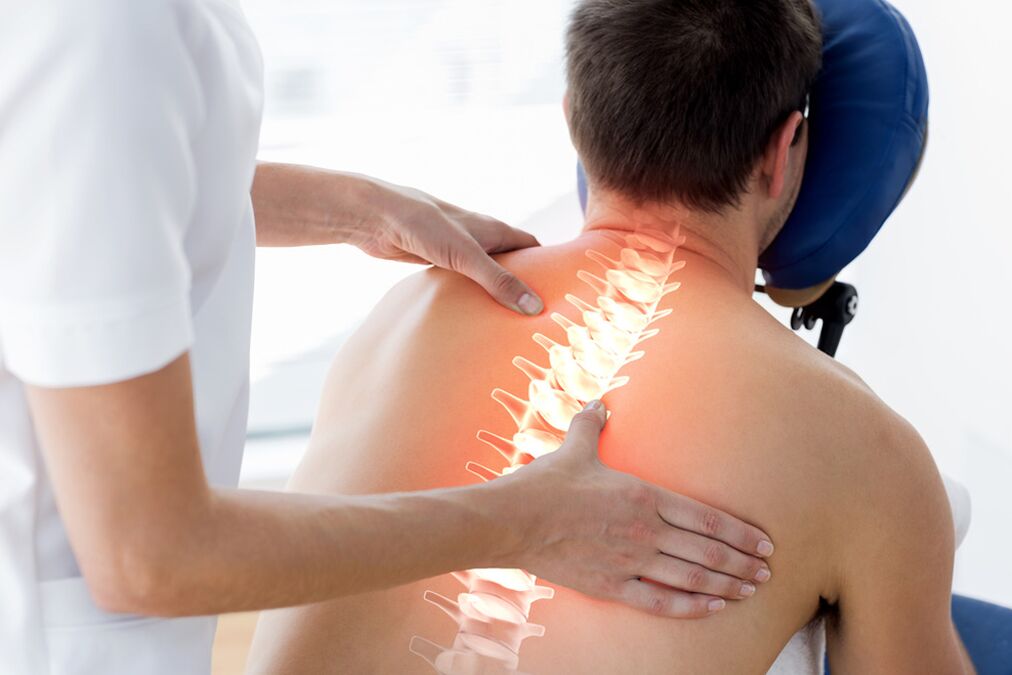Osteochondrosis is called pathological processes in the cartilage of intervertebral discs and nearby tissues. The disease can occur anywhere in the spine, however, the cervical spine is more susceptible to osteochondrosis. This is due to the anatomical characteristics of the body. The vertebrae of the neck are smaller than those of the thoracic and lumbar regions and are very close to each other. In addition, the neck is characterized by greater mobility and undergoes regular stress while holding the head.

Why the disease appears
The development of the disease is mainly associated with changes due to age. Other reasons are noted:
- lack of physical activity;
- spinal diseases;
- excessive overload;
- inadequate posture;
- unfavorable heredity;
- increased body weight;
- autoimmune diseases in which cartilage is damaged.
The condition of bone tissue and cartilage is seriously affected by nutrition. The development of pathology is facilitated by a diet lacking calcium, phosphorus, zinc, magnesium, vitamins A and E, vitamin D. The high-risk group includes office workers, professional athletes, people who do heavy physical work.
How to identify cervical osteochondrosis
The symptoms of the disease depend on the clinical case and the stage of development. The most common signs are:
- pains that affect not only the neck and head, but also other parts of the body;
- weakness, decreased sensitivity of the hands, numbness of the face;
- a snap in the neck when you need to turn your head;
- dizziness, weakness, darkening of the eyes caused by compressed blood vessels;
- deterioration of vision and hearing.
Pain in osteochondrosis of the cervical vertebrae bothers almost all patients. With the pathology, the vessels, bundles of nerve endings in the neck area are clamped. As a rule, the pain is most felt in the head, occiput, shoulders and radiates to the scapula and chest.
In the context of the disease, the heart rate can be changed. In the neck region, there are several arteries responsible for the blood supply to the brain. When blood vessels are compressed, the patient faces problems such as impaired movement coordination, arrhythmia and ischemic heart disease. In severe cases, obstruction of blood circulation leads to strokes and other potentially fatal diseases.
Stages of the disease
The progression of the disease is divided into four stages:
- In the initial stage, the bone and cartilage tissue is just beginning to decompose. The pathology manifests itself as mild pain and fatigue, which patients associate with stress.
- In the second stage, there is a decrease in the disc, the appearance of cracks. The pain increases, there may be numbness of the face and decreased sensitivity of the limbs.
- In the third stage, intervertebral hernias begin to form. The process affects muscles and blood vessels. The patient feels not only pain, but also dizziness.
- In the last stage, there is the growth of bone tissue, the nerve endings are pinched. The disease manifests itself with pronounced symptoms: pain, dizziness, numbness. Many patients have impaired motor activity.
Diagnosis
If you suspect cervical osteochondrosis, the patient needs to see a neurologist and make a diagnosis. Its task is to assess the condition of the bone and cartilage tissue. Previously, x-rays were used to diagnose diseases of the spine. Preference is now given to more advanced search methods:
- Computed tomography;
- Magnetic resonance imaging;
- duplex scanning of the cervical spine vessels.
Most of the time, the doctor prescribes a comprehensive diagnosis. It allows you to determine the presence and location of hernias, the speed of blood flow, the presence of obstacles to normal blood circulation.
Treatment
A patient diagnosed with osteochondrosis of the cervical spine needs to reconsider his lifestyle, ensure regular physical activity and eat well. To improve the condition, it is recommended to sleep on an orthopedic mattress and a comfortable pillow to relieve spine stress.
Medicines
With cervical osteochondrosis, the patient sees drugs that relieve inflammation, improve blood flow and reduce pain. The doctor prescribes drugs for vasodilation, muscle relaxants, non-steroidal anti-inflammatory drugs, drugs to improve cerebral circulation, chondroprotectants - means to restore cartilage tissue. To slow down the breakdown of bone tissue, the body needs B vitamins, calcium, phosphorus, magnesium, niacin.
Physiotherapy

Physiotherapy is the main method of treating cervical spine osteochondrosis. Experts use many procedures, the task of which is to improve metabolic processes in bone and cartilage tissue, reduce pain, relieve spasm and improve blood circulation. Here are the basic techniques:
- Shockwave therapy. . . Low frequency acoustic waves affect the cartilaginous tissue of the cervical spine. They contribute to the restoration of tissues, delay the formation of osteophytes - growths in the bones that compress nerve endings and blood vessels. The source of the low frequency waves is a special device, so the SWT course can only be taken at a medical institution.
- Massage. . . This is the most common method of conservative therapy for cervical osteochondrosis. Massage helps to improve blood circulation, relieve muscle spasms. The therapeutic massage technique is selected according to the stage of the disease and the clinical condition. This is a very important condition, because if the massage is performed in a non-professional way, it can harm the patient, causing a deterioration in well-being. It is worth giving up massage for vascular diseases, hypertension. During an exacerbation, the massage should be as gentle as possible. It is allowed to caress, rub, that is, impact the upper layers of the fabrics.
- Therapeutic gymnastics (exercise therapy). . . Exercise therapy helps to strengthen muscles and improve blood circulation. There are special sets of exercises for patients with osteochondrosis. Gymnastics can be performed not only in the office of a medical institution, but also at home. As a rule, exercise therapy is most effective during the remission period, when the patient does not experience severe pain. Wellness exercises should be combined with walking, water-based procedures.
- Acupuncture. . . It is an auxiliary method in the treatment of osteochondrosis, which is based on the effect of special needles on biologically active points. Thanks to this, the metabolism is activated, the pain syndrome decreases.
- Kinesitherapy. . . This is a hardware technique that is used to treat spinal diseases, rehabilitation after injuries. Thanks to the exercises, the load is removed from the spine, its mobility is improved and the blood circulation is restored. Kinesiotherapy classes are taught under the guidance of an instructor. There are many methods and devices for performing exercises, so an appropriate set of exercises is selected for each patient.
- Laser therapy. . . Thanks to laser radiation, a positive effect is achieved, the patient's well-being improves. The procedure reduces inflammation and pain and has a positive effect on metabolic processes.
- Electrotherapy. . . Experts use devices that are a source of pulsed galvanic alternating current. The purpose of the procedure is to reduce pain, relieve spasm and stimulate.
- Water procedures. . . Water is the best remedy for osteochondrosis. Patients with this disease are shown therapeutic baths, swimming, underwater massage. Very useful for the prevention and treatment of pathologies is a regular visit to the pool.
Osteochondrosis surgery
Spinal surgery for osteochondrosis is indicated in patients with advanced disease, in whom it is not possible to obtain remission by conservative methods. Surgery is used to remove herniated discs and affected discs. In addition, operations are performed to expand the diameter of the spinal canal, remove the vertebral arch. Its goal is to eliminate the compression of nerves and spinal cord, which allows you to get rid of discomfort.
All manipulations are performed under anesthesia, using X-rays and microsurgical control.
For disc protrusion, the laser discectomy method is used. This is a minimally invasive technique that allows you to vaporize the pulpous nucleus of the disc using a laser beam and thus eliminate compression.
Nutrition for osteochondrosis
Inadequate nutrition increases the risk of developing degenerative dystrophic diseases of the musculoskeletal system, which include osteochondrosis. To slow the pathological processes in the bones and cartilage, it is necessary to provide the body with a sufficient amount of vitamins and minerals. The diet should include:
- dairy products - a source of calcium;
- fresh vegetables and herbs;
- legumes, nuts, seeds - a source of proteins, magnesium, B vitamins;
- Cereals, bakery products with the addition of whole grains;
- lean meat;
- Fish and seafood;
- olive oil and other vegetable oils;
- jam, meat with jam, dishes with jam.
There are no strict dietary restrictions, but there are undesirable foods for consumption in large quantities. Firstly, it is strong tea and coffee, which impair the absorption of calcium and vitamins. Foods with a high salt content also do not help.























